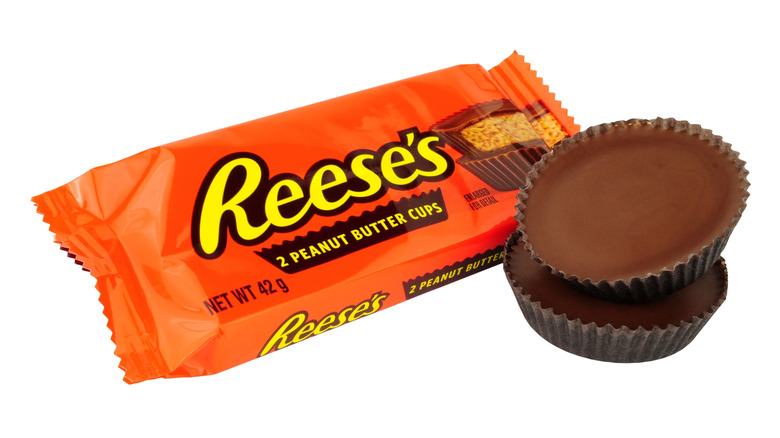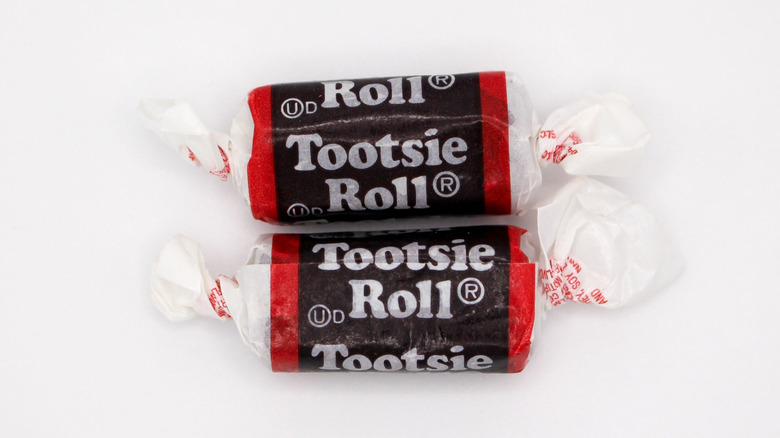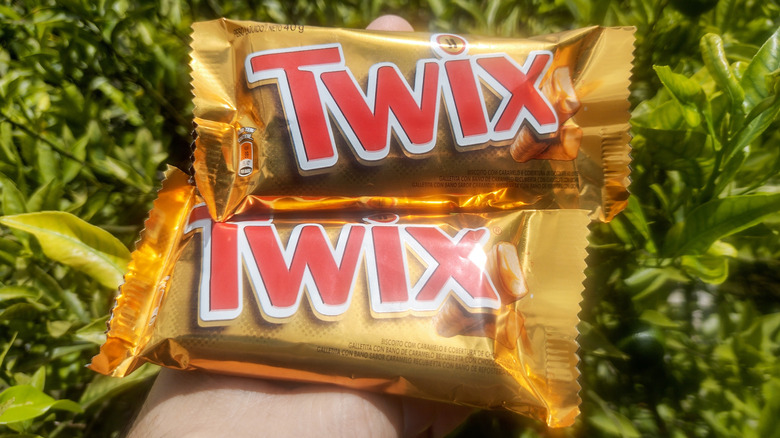10 Chocolate Brands That Use The Lowest Quality Ingredients
Let's face it — chocolate is one of the greatest inventions ever. Rich, velvety, sweet, or bitter, there is no shortage of ways to describe this classic confection. It was first used in South America by the ancient Maya, who turned it into a bitter-tasting drink long before the term "chocoholic" existed. It's fair to say that chocolate has come a long way since then. Today, store shelves are stocked with countless varieties of delectable bars, candies, and assorted treats — a far cry from the pure cacao experience enjoyed by the Mayans. Chocolate lovers can even indulge in chocolate-infused Velveeta truffles, proving that there is no limit to what this tantalizing sweet can do.
A fact you should know about chocolate is that it is loaded with antioxidants, molecules that can potentially tackle disease-causing free radicals. Despite having nutritious benefits, many chocolate brands fill their bars with less-than-quality ingredients. Some milk chocolate bars use so little cocoa solids that it's questionable whether or not they should even be considered chocolate. In recent years, several brands have even been accused of having potentially harmful levels of lead and cadmium in their candies too, according to research done by Consumer Reports.
Though we totally support and encourage mass chocolate consumption, some brands are clearly better than others when it comes to the quality of their chocolate. This list includes the chocolate brands you'll want to avoid, on account of the quality of the cocoa, added sugars, extra food additives, and the like.
Butterfinger
Butterfinger has held a special place in the hearts of chocolate lovers since Bart Simpson's legendary run of commercials in the '90s. It's a "crispety, crunchety" peanut butter-filled, chocolate-coated bar sold in an iconic yellow and blue wrapper. This candy, which is owned by the same company behind Ferrero Rocher, was updated with a new recipe in 2018. The peanuts were replaced with higher quality ones and the "chocolate" coating was revamped, resulting in richer, less waxy chocolate, a more authentic roasted peanut flavor, and an enhanced aftertaste.
Despite Ferrero's purported improvements, Butterfinger still lacks in the chocolate department. A closer look at the ingredients reveals why: It contains less than 2% cocoa. It's mostly sugar and saturated fat, an undeniably tasty duo that, sadly, lacks the richness and creamy texture of cocoa butter. Quality milk chocolate is smooth and shiny rather than waxy and plastic-like. Butterfinger's artificial chocolate has a flexible, foldable consistency that easily melts, unlike properly tempered chocolate, which retains its shape at room temperature and makes a snap sound when it's broken.
3 Musketeers
This Alexandre Dumas-inspired chocolate bar is three times as likely to give you a sugar high. Jokes aside, 3 Musketeers contains much more sugar than other chocolate bar brands. Sugar pairs awesomely with chocolate because it helps balance bitterness and enhance complex notes. But, when sugar constitutes such a big proportion of the ingredients list, you're ultimately consuming more sugar than you are chocolate. The milk chocolate in 3 Musketeers is not the rich and velvety kind either. It's crumbly instead of creamy and can leave you with candy debris to clean up.
The chocolate coating layer is also super thin, melts easily in your hands, and gets overpowered by the whipped nougat mousse. What's more, complaints amongst long-time fans have ramped up recently, highlighting a noticeable decline in the overall quality of the candy. There is nothing wrong with indulging in saccharine bliss now and again, but you can also alternate with grocery store dark chocolate brands that have a higher percentage of cocoa solids to get your fix in.
Cadbury
There is a tug-o-war between American and British food regulations. Certain American confections contain food additives that are legal to use in the States, but banned in the U.K. That begs the question, "If it isn't allowed there, why is it allowed in America?"
Unsurprisingly, U.S. chocolate tastes different from European chocolate because of food regulations. Milk chocolate is only considered "real" in the U.K. if it's made with 30% or more cocoa, whereas the U.S. only requires 10%. As you can imagine, that results in noticeably different flavors and textures. Both countries are known for producing less-than-high-quality chocolate brands, though. Cadbury, the "Hershey's" of Britain and, coincidentally enough, a brand owned and produced by Hershey in the States, falls into that category.
Hershey uses several emulsifiers in its Cadbury products to reduce viscosity and help give them a consistent texture and taste. One of Cadbury's best chocolate bars, Dairy Milk, includes PGPR (polyglycerol polyricinoleate) and lecithin: two emulsifiers commonly used in food products. While they do a fair job mimicking the creaminess of a high-quality bar, Cadbury still pales in comparison to the delectable consistency of other chocolate brands. It's unmistakably waxy, and some even say it's greasy. Many consider Cadbury's chocolate to be overpoweringly sweet, unlike other chocolate brands that balance sweetness with roasted flavors and/or bitterness. Cadbury's chocolates have become the target of long-time fans, who lament the decadent chocolate brand they grew up eating.
Toblerone
Toblerone may no longer be Swiss enough to use the Matterhorn logo, but it's still made with creamy Swiss milk chocolate. The unique angular shape adds a fun, interactive element to eating the bar that makes it hard to put down. The brand offers a range of options to choose from, including milk, white, and dark chocolate.
When it comes down to ingredients, biting into a Toblerone is like diving into a pool of sugar. The Environmental Working Group calculates that the brand's Swiss milk chocolate with honey and almond nougat bar is 61% sugar by weight. Its other bars don't fare much better, either. The milk chocolate in this Toblerone bar is made of 28% cocoa solids and 14% milk solids. That's more than others on this list, though less than a high-ranked chocolate brand like Lake Champlain, which uses 38% cocoa solids in its milk chocolate. Cocoa percentage is an indicator of taste, texture, and quality. The lower the percentage, the higher the amount of "other things," like sugar and food additives, are in the bar.
The Toblerone taste you've come to love is closer to chocolate-flavored sugar than to quality chocolate. Its dark chocolate contains around 50% cocoa solids, so it is the higher-quality option. While this bar might not be the highest-quality one out there, there's no doubt that it still is quite tasty.
Baby Ruth
A 1920s dispute over the name "Baby Ruth" between the famed baseball player and the original candy maker may not have ruled in favor of the former, but most people still associate the candy with the "King of Swing." Since then, Baby Ruth has grown into one of the most beloved "chocolate" bars in the U.S. It's a blend of peanuts, caramel, and milk-chocolate flavored nougat, all covered in compound chocolate. The key phrase here is "compound chocolate," which consists mainly of vegetable fat rather than cocoa butter. It's basically a cheaper chocolate alternative.
Baby Ruth doesn't contain much of any real chocolate, in fact. Compound chocolate typically includes no more than 8 to 18% cocoa. That doesn't quite capture the taste and toothsome texture of chocolate made with cocoa butter. Compound chocolate also takes longer to melt and lacks a robust aroma, too. Between that and the copious amount of saturated fat in this bar, Baby Ruth may not be the best option for all eaters.
Milky Way
Milky Way bars have a flavor that is out of this world. The American version, not to be confused with one of the U.K.'s oldest and most popular candies, is made with milk chocolate and caramel-topped nougat. Each 1.84-ounce bar delivers 32 grams of sugar, which is nearly three times the sugar in a single Krispy Kreme glazed donut. Therefore, it's easy to see why Milky Way's "rich chocolate" is anything but.
There is indeed cocoa butter in this bar, but the exact percentage is unknown. Nougat is the dominant flavor, and it's one that tends to overwhelm the thin chocolate coating — which has a one-note artificial taste. Palm oil is another concerning addition. While it extends the shelf life of the bar, it also gives chocolate an unappealing oiliness that layers the mouth. Don't let chocolate snobbery stop you from enjoying Milky Way though; it's still one of the most delicious chocolate bars.
Yorkie
Nestlé's portfolio of chocolate brands is longer than a CVS receipt. Yorkie comes from the company's U.K. leg and is considered one of the country's most popular chocolate bars. It has a controversial, misogynistic history, though. The candy, which was previously named "Rations," was initially marketed specifically to men. Nestlé eventually purchased it and curiously chose to stick with the overly macho, cringy tagline, "It's not for girls," though this tagline was removed in 2012. If it weren't for that, Yorkie would easily be one of the best British chocolate candies.
Back to our regularly scheduled confections, though. Yorkie is marketed as being free from artificial colors, flavors, and preservatives, but a closer inspection of its ingredients reveals a jaw-dropping amount of saturated fat, along with a starting lineup of vegetable oils. Unsurprisingly, fans say its clunky chunks have an over-soft, oily consistency. The taste is sugary with a subtle artificial cocoa flavor, too. Trust us, there is nothing unmanly about leaving this bar on the shelf.
Reese's peanut butter cups
Reese's peanut butter cups need no introduction. It's a classic combination of chocolate and peanut butter that's been satisfying sweet tooths since 1928. Iconic taste aside, a Reese's peanut butter cup may not be the highest-quality chocolate candy out there. It contains actual cocoa butter and chocolate, but the brand doesn't share how much it uses. The inclusion of questionable ingredients, like lecithin and PGPR, may also contribute to the candy's artificial and waxy mouthfeel.
What's more, Reese's fans say it leaves a chemical aftertaste, that's oddly enough, close to cigarettes and nail polish. Compared to brands that use higher-quality ingredients, the delectable chocolate and peanut butter blend you've come to love tastes almost chalk-like and has a rubbery texture. Its peanut butter-forward flavor is overwhelmingly sweet and the chocolate barely peaks through before it's overshadowed. The brand's other Reese's products use similar ingredients to its original recipe, too.
Tootsie Roll
Tootsie Roll is a popular chocolate brand on this list, though some folks may not think it's chocolatey at all. The flavor of Tootsie Rolls is pretty hard to pin down. It appears to be a solid, chew-worthy mass of chocolate with notes of caramel and a taffy consistency. The official website describes it as having a little bit of fruit flavor too, which causes even further confusion. According to the ingredients list, however, the undeniably classic Tootsie Roll taste comes from compound chocolate.
Compared to real chocolate, Tootsie Rolls have a tough, less-than-creamy bite. They don't even melt in your mouth; instead, they just stick to the sides of your molars and between your teeth. Some would say that's the best part, but in reality, it's a sign of low-quality attempt at "chocolate." That said, the ingredient list doesn't prevent Tootsie Rolls from becoming one of the most consumed candies in the U.S.
Twix
Twix is a crunch-tastic cookie layered with rich caramel and coated with silky chocolate. Biting into this chocolatey cookie bar is the perfect candy fix, and unsurprisingly, a one-way ticket to a sugar town. This iconic brand packs a ton of sugar into its golden foil, along with an almost cardboard-like chocolate.
As undeniable as Twix is, fans have criticized its taste in recent years. What was once a creamy chocolate bar with drippy caramel has become an odd-tasting, stale confection to many. It's made with milk chocolate, but it also includes food additives, palm oil, corn syrup, and artificial flavors — so that might have something to do with it. Don't let us keep you from enjoying the candy or making a decadent Twix-topped chocolate dessert, though. A super sweet-sperience is sometimes just what the doctor ordered.










